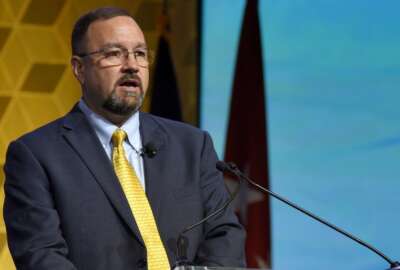
DIA’s new unclassified software factory to give classified apps a boost too
EP Mathew, the DIA deputy chief information officer, said the first software factory available for use by the Five Eyes will help ensure data interoperability.
For the Defense Intelligence Agency, the move to the multi-cloud contract called C2E is all about data interoperability.
Sharing and disseminating data with other intelligence community partners, with other Defense Department agencies and with foreign allies is driving much of DIA’s IT modernization goals.
EP Mathew, the DIA deputy chief information officer, said DIA is making data sharing easier and secure by building a capability delivery pipeline, which will include a software factory at the unclassified level.

“When you create a software factory at the unclassified level, you don’t need to get software developers that are top secret/sensitive compartmented information (TS/SCI) cleared. You can get them at a much cheaper and it makes you have the ability to acquire software engineers at a much cheaper and faster level,” Mathew said after his speech at the recent ACT-IAC Emerging Technology and Innovation Conference. “In addition to that, once you build that pipeline, you are designing data standards and security standards from the very beginning. Typically, we are very application centric. What ends up happening is when you decentralize the building of applications, sometimes security is an afterthought, and so by doing this and creating this pipeline, all those standards are set up upfront, and along with the ability to interpret interoperate amongst multiple clients.”
By having the software factory at the unclassified level, DIA can easily move the application to the classified side, as well as the data instead of having to build two separate applications and adding complexity to how they manage the data.
Mathew said the DIA software factory will be the first among the Five Eyes or closes American allies like the U.K., Australia and New Zealand. Those countries also will be able to build software using the same standards and processes, making interoperability that much easier.
“I have to design and build systems that are interoperable because if I don’t, I can’t adopt a native service that’s in one cloud and that is inoperable in another cloud. I have to make the data inoperable across all the clouds so that I can share that within the IC community,” he said. “I’d have to make the data interoperable so I can share it with my foreign partners, Five Eye partners, traditional partners, NATO partners. The ability to make the data interoperable becomes so critical because if you cannot disseminate intelligence, its value becomes limited.”
DIA’s plan to take more advantage of C2E also underpins its human resources modernization effort.
The agency released a request for information in April, seeking feedback for how best to develop a new human resources information system, adopt industry-best practices, automate processes and provide employees with trusted, on-demand data. Responses were due May 4.
Mathew said this was the first step toward the “largest transformation in our HR system in about 20 years.”
He said the focus is across four areas:
- Improving the hiring experience
- Improving their computing processes
- Improving their quality control so HR processes are done correctly the first time
- Adopt a new HR system
“If you’re looking at the adopt, buy and then create model, adopt is a lot easier than buying and, buying is a lot easier than creating. Our goal is if there was a software-as-a-service (SaaS) system, it’s a lot easier to adopt. If there isn’t, we’ll buy something. And then lastly, I don’t think we will need to do this, but we would need to create something if we can’t buy or adopt. We are really lucky to be in the adopter by space,” Mathew said. “Typically, when we go and buy a large IT modernization system, we will look in with our partners and say, ‘OK, what have they done?’ Our goal is why learn a lesson when someone else has already gone through that research? This will be part of our due diligence that we will do.”
DIA hopes to issue a solicitation for the new HR system in fiscal 2024.
Another priority, over the shorter term, is for DIA to expand its shared service for TS/SCI desktop services.
Mathew said DIA will begin managing about 7,500 of these high-end classified desktops, taking over from the Defense Information Systems Agency in 2024.
“I think what most people don’t realize about the DIA CIO is the IC has roughly the unclassified numbers into roughly 16,000 people. But we also provide the desktops at the TS/SCI level for about another roughly 50,000 or so. We actually provide the desktop services for other parts of the IC. A lot of the smaller mom and pop type agencies need a small footprint of TS/SCI desktops. It’s a lot easier for them to come to use our company storefront model to adopt as a fee for service,” he said. “Likewise, one of the things that we’re also looking to do in the future is can we adopt DISA services? Meaning can DISA provide our desktop for the unclassified and secret levels? We believe we’re the best on the TS/SCI side, but when you maintain three environments, you dilute your focus and if DISA does unclassified and secret better than us, why not adopt from them?”
Copyright © 2024 Federal News Network. All rights reserved. This website is not intended for users located within the European Economic Area.
Jason Miller is executive editor of Federal News Network and directs news coverage on the people, policy and programs of the federal government.
Follow @jmillerWFED
Related Stories

As C2E gets going, DIA sets its strategy for more cloud services




